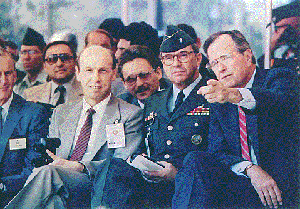| |
|
When the
treaty entered into force on June 1, 1988, the Soviet
Union and the United States listed 12 elimination sites
in the revised data exchange in the official Memorandum
of Understanding. In the same document, they designated
which missile system would be eliminated at each site. The
United States declared it would eliminate 846 INF
missiles, as well as launchers and associated equipment.
All were grouped into three major weapons systems: the
Pershing II (234) and Pershing IA (169) owned and
operated by the U.S. Army, and the BGM-109 GLCMs (443) of
the U.S. Air Force. Once the treaty went into effect, the
military services were responsible, upon receipt of
appropriate orders, for removing the INF missiles and
launchers from operational status, for transporting them
to the elimination sites, and for conducting the actual
eliminations. Four sites were used: three in the
continental United States and one in West Germany. In the
United States, the Longhorn Army Ammunition Plant in
Marshall, Texas, would eliminate all Pershing IA and a
portion of the Pershing II missile stages. The Pueblo
Depot Activity in Pueblo, Colorado, was the site for
eliminating the other portion of the Pershing II missiles
and selected Pershing II launchers. In Europe, the
elimination site was located at the U.S. Army's Equipment
Maintenance Center at Hausen, West Germany. There,
Pershing II launchers would be eliminated. The Air Force
selected Davis-Monthan Air Force Base in Tucson, Arizona,
as the site for destroying its GLCM missiles and
launchers. The Army and Air Force had to complete all
eliminations within the deadlines set by the treaty: 18
months for the shorter-range missile systems and three
years for the intermediate-range systems.2
The USSR declared it would eliminate 1,846 INF
missiles. Eight sites were used, all within the Soviet
Union. In the eastern USSR, two military bases, Kansk and
Chita, served as elimination sites where a small number
of SS-20 missiles were launched to destruction. The
treaty permitted each party the right to destroy up to
100 missiles through launching. This activity had to be
completed by December 1, 1988. Saryozek in the eastern
Soviet Union served as the elimination site for SS-12 and
SS-23 missiles. On the European side of the Ural
Mountains, in the western USSR, five sites were used for
eliminating INF missiles. At Kapustin Yar, SS-20 missiles
would be destroyed though explosive demolition. At
Stan'kovo, SS-12 and SS-23 transporter-erector-launcher
(TEL) vehicles would be eliminated, while at Sarny, SS-20
(TEL) vehicles were scheduled for elimination. At
Lesnaya, SS-4 and SS-5 missiles and components would be
destroyed. At Jelgava, the nondeployed SSC-X-4 missiles
and launchers would be destroyed.3
Map of INF
Elimination Sites in the U.S.
Map of
Soviet Elimination Sites
|
